LES INDIENS ARCHAIQUES 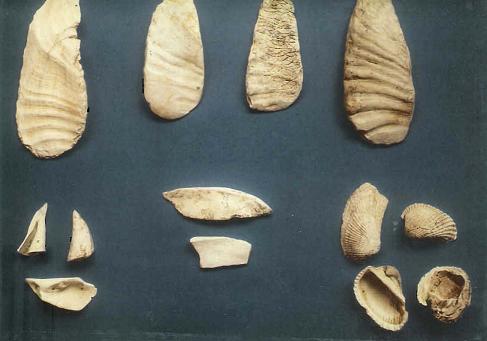
Il y a environ 4000 ans, quelques 3500 ans avant Christophe Colomb, les premiers habitants de Saint-Martin sont arrivés ; ils voyagèrent a partir du Venezuela au moyen de canoës, a travers toute la chaine des Petites Antilles.
Ces indiens, semi-nomades, étaient nommés Ciboney, ce qui signifiait Peuple de la Pierre. Ils ne pratiquaient pas l’agriculture et ne savaient pas fabriquer de céramique. C'était un peuple vivant de cueillette de baies sauvages, se nourrissant de coquillages marins, de racines et de fruits.
Les principaux vestiges que l'on trouve aux lieux ou ils vécurent sont 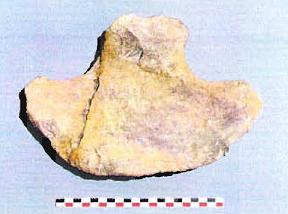 des coquillages travailles ou non, des outils en pierre et des éclats de silex.
des coquillages travailles ou non, des outils en pierre et des éclats de silex.
THE ARCHAIC PHASE
The first inhabitants of Saint-Martin probably arrived about 4000 years ago, some 3500 years before Christopher Columbus; using canoes or rafts. They traveled from the region of Venezuela through the whole chain of the Lesser Antilles. 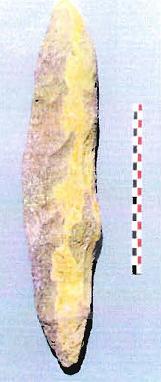
These semi-nomadic Indians were probably named "Ciboney", which meant "stone people". They did not practice agriculture and did not know the manufacture of ceramics. They were a wandering people, collecting and living on shellfish, wild nuts, roots and fruits.
The remains that are found in the places where they lived are shells, shaped or not, stone tools and flints.
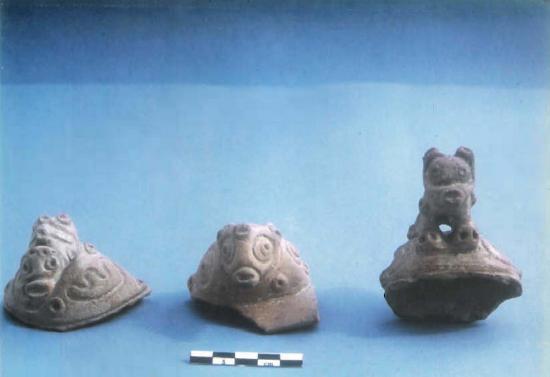
LA PHASE HUECAN-SALADOIDE
Les premiers indiens céramistes de Saint-Martin arrivèrent il y a environ 2500 ans (500 a600 B.C.).
Ces "Saint-Martinois" étaient probablement de langue Arawak et avaient rapidement migré à partir des Andes vers les Guyanes, puis vers l'actuelle cote nord-est du Venezuela, et enfin vers les iles de la Caraïbe.
Leur origine andine est suggérée par la présence d'amulettes en forme de condor.
A mesure qu'ils progressaient dans leur exploration à travers l'arc antillais, ils amenaient avec eux toutes leurs traditions, dont les origines se trouvent sur le continent sud américain.
Les "huecan-saladoides" tirent leur nom de "La Hueca", site archéologique exceptionnel, découvert sur la 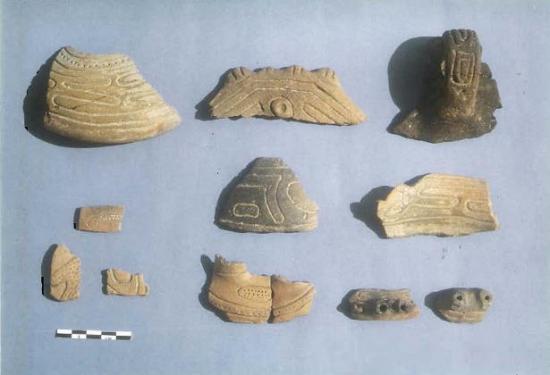 cote Sud Ouest de l’ile de Vieques, située au large de la cote Est de Puerto Rico.
cote Sud Ouest de l’ile de Vieques, située au large de la cote Est de Puerto Rico.
Ces Indiens vivaient de pêche, de chasse et cultivaient le manioc.
Le matériel témoignant du passage de ces indiens aussi bien a Vieques, Puerto Rico, Montserrat et Saint Martin est caractérisé par la présence de céramiques de très faible épaisseur, dépourvues de peinture, avec parfois des décors curvilignes, modèles et incisés.
Les décors modèles en forme de chien sont typiques de l’époque huecoide.
L'outillage qu'ils utilisaient était en coquillage, en bois ou en pierre. Les haches à oreilles et à encoches sont typiquement huecan-saladoides.
Les décors des céramiques et la présence d'amulettes en forme de condor, ou symbolisant la grenouille, taillées dans la pierre ou la nacre, montrent que ces indiens pratiquaient des rites religieux.
THE HUECAN SALADOID PHASE
The first ceramic-making Indians of Saint-Martin arrived about 2500 years ago (500 to 600 B.C.). These Amerindians most likely spoke an Arawak language. They had migrated from the Andes to the Guyanas, then to the current North-Eastern coast of Venezuela and finally into the Antilles.
Their Andean origin is suggested by the presence of condor-shaped amulets, found in Vieques. As fast as they advanced in their exploration across the West Indian arc, they carried all their traditions originating from the South American continent.
The name "Huecan saladoid" is derived from La Hueca, an exceptional archaeological site, discovered on the South-Western Coast of Vieques Island, to the East of Puerto-Rico.
These Indians lived on fishing, hunting and grew manioc and other staple crops. The material which shows these Indians arrival in Vieques as well as in Puerto-Rico and Saint-Martin is typically a very thin fine ceramic, unpainted, sometimes decorated with curvilinear, modeled and incised adornments. Dog shaped modeled adornments are typical of the Huecan saladoid period.
The tools that they used were made of shells, wood or stones. Eared and notched axes are, apparently, typically Huecan saladoid.
The characteristic adorned pottery and the existence of condor shaped amulets or other symbolizing the frog, cut into stones, shells, mother of pearl or mica, suggest that these Indians practiced religious rituals.
LA PHASE CEDROSAN-SALADOIDE
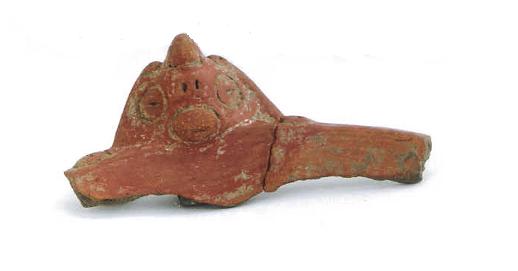
Les indiens "Cedrosan-saladoïdes" doivent leur nom au site de Saladero, situe dans le bassin de l'Orénoque, ou ont été trouvés des traits culturels identiques a ceux que l'on rencontre dans les sites archéologiques des Antilles. C’est à Cedros, dans l’ile de Trinidad que leurs céramiques sont pour la première fois mises au jour.
Ils représentent la troisième vague de migration de langue arawak à partir du bassin de l'Orénoque, vers les iles de la Caraïbe.
On les rencontre à Saint-Martin, pour la première fois, il y a 2250 ans (300-200 B.C.) sur le site de Hope Estate. Ils ont probablement noué des contacts et des échanges culturels avec les "huecan-saladoides" qui étaient déjà sur place.
Ces "Cedrosan-saladoides", qui à l’ origine possédaient des traits culturels continentaux typiques, se sont modifies en s'adaptant au milieu insulaire. On les rencontre alors dans la littérature sous le nom de "saladoides modifiés" ou "saladoides insulaires".
Plus tard, en atteignant les Grandes Antilles, leur art s'est développé, tant dans le domaine de la sculpture sur bois, os, coquillage ou pierre, que de la poterie. Ce sont ces indiens qui accueillaient Christophe Colomb sur l'Ile d'Hispaniola en criant : "Taino ! Taino", qui signifiait "Paix ! Paix !". C'est pourquoi les amérindiens des Grandes Antilles sont aujourd'hui encore appelés les Tainos.
Les Cedrosan-saladoides étaient organisés en sociétés tribales et établissaient de petits villages de 4 a 9 carbets.
C'était un peuple qui cultivait le manioc, pêchait des tortues, des poissons marins, des crustacés et des mollusques. Ils chassaient également les oiseaux, certains rongeurs, le Lamentin, l’Agouti et les Iguanes.
La céramique saladoide est caractérisée par la présence de décors peints en rouge, et parfois en blanc sur rouge. On rencontre également des décors polychromes blanc/orange/roug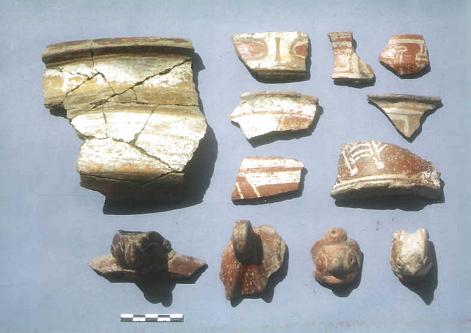 e, et incises simples ou hachures (crosshatch).
e, et incises simples ou hachures (crosshatch).
Enfin, la forme tronconique de certains récipients en forme de cloche inversée et les figurines modelées et appliquées sur les pots (Adornos) sont typiquement Cedrosan-saladoides.
Les "Cedrosan-saladoides" utilisaient la pierre et les coquillages pour fabriquer leurs haches, leurs outils et leurs amulettes.
Des rituels funéraires existaient et les morts étaient généralement enterres en position fœtale.
Ils avaient des pratiques religieuses et matérialisaient leurs dieux en sculptant le nacre et les pierres a Saint-Martin, deux blocs comportant des visages de diorite sculptés (Pétroglyphes) ont été découverts près du puits de Moho et sur le site de Hope Estate.
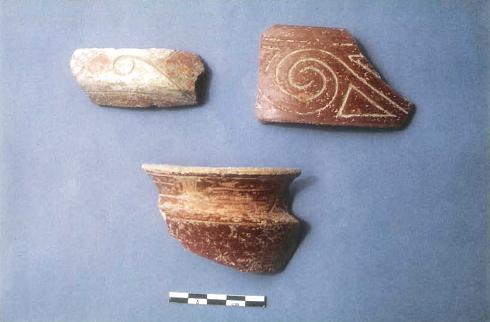
THE CEDROSAN SALADOID PHASE
The "Cedrosan saladoid" Indians are so named because of their connection to the Saladero site, located in the Orinoco basin, in Venezuela, where have been encountered identical artifact features as those that are found in archaeological sites throughout the West Indies. Excavations conducted in Cedros, on the island of Trinidad have shown the presence of their ceramics in the Caribbean Islands for the first time.
They represent the third wave of migration of Arawak speaking Indians from the Orinoco basin through the Caribbean islands.
In Saint-Martin, these Indians are encountered for the first time some 2250 years ago (300-200 B.C.) on the "Hope Estate" site. They possibly had contacts and cultural exchanges with the "Huecan saladoids" who were already settled there. These Cedrosan saladoids, who at the beginning had typical continental cultural traits, started to modify while they adapted themselves to the insular environment. They are then referred to in the literature as "modified Saladoids" or "insular Saladoids". Later, reaching into the Greater Antilles, their art developed in wood carving, stone, bone and shell shaping, and in pottery. These Indians were the ones who greeted Christopher Columbus on Hispaniola island crying: "Taino! Taino!", which meant "Peace! Peace!". That is why the Amerindians of the Greater Antilles are still called the "Tainos".
The Cedrosan saladoids were organized in tribal societies and established small villages composed of a number of "carbets", or houses.
Their main activities were manioc cultivation and turtle, fish, shellfish and mollusk fishing. They also hunted sea birds, rodents, manatees and agouties, as well as iguanas.
The typical Cedrosan saladoid ceramic is composed of red painted pottery and sometimes of white on red designs. We also meet polychromic adornments, white-orange-red and simple crosshatched incisions.
Finally, inverted  bell shaped bowls and modeled figurines applied on the pot (adornos) are typically Cedrosan saladoid.
bell shaped bowls and modeled figurines applied on the pot (adornos) are typically Cedrosan saladoid.
The "Cedrosan saladoids" used stones and shells to manufacture their axes, tools and amulets. Funeral rituals existed and their dead were buried in a foetal position. They had religious practices and materialized their gods by cutting and shaping shell, wood and stones. In Saint-Martin, two dioritic blocks on which were carved faces, called petroglyphs, have been discovered near Moho spring and on the Hope Estate site.
LES PHASES TARDIVES ELENAN/OSTIONAN OSTIONOIDES, MARMORAN/SUAZAN TROUMASSOIDES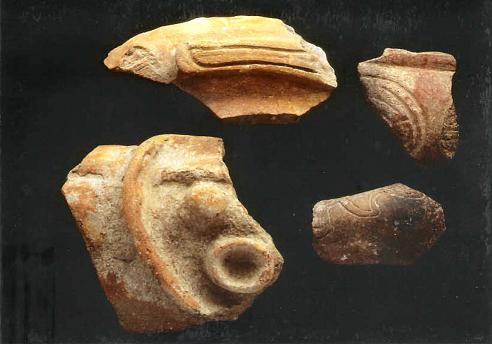
Parmi les indiens Cedrosan-saladoides avant atteint les Grandes Antilles au cours de la troisième phase de migration, certains ont eu des contacts et ont effectue des échanges avec les descendants des indiens archaïques de la première phase,
Le mélange des deux cultures donna naissance au développement de cultures locales comme les "Ostionan-ostionoides", les "Elenan-ostionoides" a Puerto Rico et les "Suazan-troumassoides" a Grenada.
Ces indiens migrèrent dans les Iles de l’arc antillais et atteignirent Saint-Martin entre 800 et 1200 ap. J.C.
Les sites tardifs se situent généralement en bord de mer et leurs restes alimentaires sont essentiellement constitues d'animaux marins (poissons, crustacés, mollusques, tortues). Ces indiens cultivaient le manioc comme le montrent les nombreux morceaux de platines a manioc rencontrés sur les sites.
Leur céramique est souvent grossière, parfois incisée, modelée ou peinte en rouge. 
Leurs outils de pierre ressemblent à ceux des indiens Cedrosan-saladoides alors que les gouges en coquillage (Strombus gigas) ont des formes archaïques.
On rencontre dans les sites tardifs, des pierres ou des madrépores sculptés à trois pointes, représentant leur dieu de la fertilité Yocahu.
Leurs morts étaient enterres verticalement en position fœtale.
THE LATE PHASES: ELENAN/OSTIONAN OSTIONOID, MARMORAN/SUAZAN TROUMASSOID
 Among the Cedrosan saladoid Indians who reached the Greater Antilles during the third migration phase, some established contacts and had cultural exchanges with the archaic Indians descended from the first phase of settlement.
Among the Cedrosan saladoid Indians who reached the Greater Antilles during the third migration phase, some established contacts and had cultural exchanges with the archaic Indians descended from the first phase of settlement.
The mixing of these two cultures gave birth to local cultures developments as "Ostionan-ostionoids", and "Elenan-ostionoids" in Puerto-Rico and" Suazan-troumassoids" in Grenada.
These Indians spread back to the West Indian arc of Antillean islands and reached Saint-Martin between 800 A.D. and 1200 A.D.
These latest sites are generally located on the seaside and their food remains are mostly composed of sea animals (fishes, shell fishes, mollusks, turtles). These Indians raised manioc as is indicated by the amount of manioc griddle shards that are found on the sites.
Their ceramics are often rough, sometimes incised, modeled or painted in red. 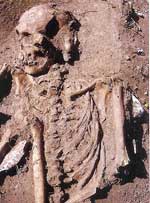
Their stone tools look like the saladoid ones while their shell gouges have archaic shapes.
In the late sites, we meet stone or corals worked into "tree pointers", idols representing their fertility god Yocahu. Their dead were buried vertically, in a foetal position.
LES INDIENS CARAIBES
Une quatrième phase d'invasion eut lieu à partir des cotes du Venezuela, juste avant l’arrivée de Christophe Colomb"
Ces indiens belliqueux, parfois décrits comme des anthropophages; Le mot "cannibale" est issu de leur nom en espagnol : "caribales", n'atteignirent jamais Saint-Martin contrairement aune croyance populaire.
Ce sont ces indiens caraïbes qui opposèrent le plus de résistance à la colonisation des Antilles par les Grands Royaumes d'Europe.
THE CARIB PHASE 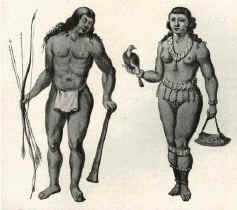
A fourth invasion phase occurred from the South American coast, just before the arrival of Christopher Columbus. These warlike Indians, sometimes described as anthropophagous - the word cannibal" has its origin in their Spanish name: “carribales”- never reached Saint-Martin contrary to a popular belief.
It is these Carib Indians who resisted the most against the West Indian colonization by the great kingdoms of Europe.